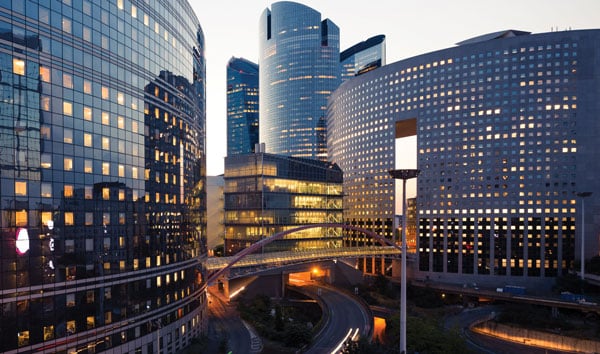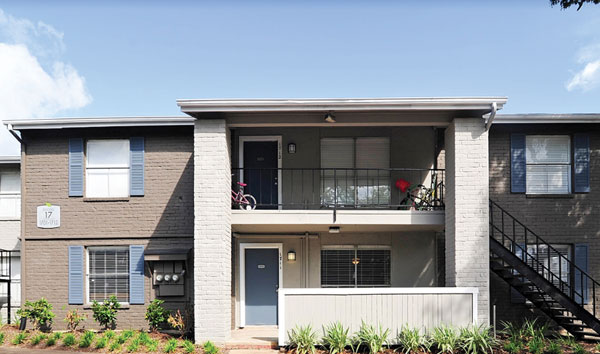
When Miami-based private equity firm Safe Harbor Equity launched its distressed CRE debt fund earlier this year it had a fundraising goal of $100 million. Then founder Ralph Serrano went on a fundraising tour of Europe and Asia and found a surprising amount of interest from investors. He quickly scaled up the fund to $200 million.
"We received a lot of interest from the people we were speaking to but most felt that they would want to write bigger checks and a $100 million fund wouldn't accommodate that," he says.
At first glance, the telling story here would be the enthusiasm expressed in distressed CRE debt—a sign, perhaps, that the industry must brace for a global slowdown in growth. A more significant note to make is Serrano's international road tour. "Our focus was to seek capital outside of US, because the expectations of foreign investors are much more moderated," he says. "Foreign investors seem to be very pleased with a low double-digit return or mid-teens return and domestic investors have greater appetite for higher returns."
It is, in short, yet another sign of globalization among the world's CRE markets and investors—and one that happens to benefit the US. The US real estate markets have traditionally been an investment destination for foreign capital, however, a shift has occurred with global CRE investment flows as of late. More institutional investors and asset managers are increasingly willing to make cross-border plays in other parts of the world, exploring new markets. Global CRE investment has also been declining this year for various reasons, including fears of a worldwide economic slowdown. Little wonder indeed, that Safe Harbor Equity saw so much interest in its fund. In the first quarter of 2019 alone, funds planning to invest in troubled property assets raised $8 billion, according to Preqin figures. Such funds raised less than $1 billion last year and $3.3 billion in 2017. In 2019 year-to-date, funds targeting distressed real estate have raised $9.8 billion.
"There is no doubt we see an interest level in this asset class globally," Serrano says. "After the last downturn many investors recognized that distressed debt is an important asset class for its risk return ratios and ability to achieve alpha."
But to put the level of global CRE distressed fundraising into better perspective, it is important to first get a sense of the overall investment flows. And those are changing.
Global CRE Winners and Losers This Year
Global real estate sales transactions totaled $341 billion in the first half of this year, JLL reports. Among the most significant of these cross-border deals was Brookfield's $1.5 billion acquisition of a mixed-use commercial complex in Shanghai. It is a telling transaction not only for its size—it is one of the largest purchases by a foreign investor in China to date, according to JLL—but also because it so aptly illustrates the robust appetite that global asset managers and investors continue to have for real estate around the world, outside of the US.
This year Asia has become an increasingly popular CRE investment destination among investors from the Americas and the rest of the world; indeed CBRE reports that CRE investment by Westerners in China and Singapore grew by 329% and 71%, respectively, for the first half of this year, compared with the same time period in 2018, exceeding $3.7 billion.
Another reason why the Brookfield deal stands out: it adds nuance to the narrative that global CRE deals have started to fall, and strictly speaking, they have. For the first half of the year, year-on-year sales transaction activity dipped by 9%, JLL reports, "representing a level of softening in line with expectations," it said. Another JLL stat to note: Q2 2019 saw the four-quarter rolling average of total global cross-border activity hit its lowest point since Q2 2017.
The nuance is this: Investor sentiment remains strong, as the Brookfield deal illustrates, and dry powder is accumulating at a rapid clip with fundraising by private closed-end real estate funds reaching its highest first-half level at $80.3 billion. Dry powder now stands at a record $331 billion, JLL said, and funds closing in H1 2019 were oversubscribed by an average of $167 million or 7% more than initially targeted. The issue for many, if not most, of these funds is the difficulty in sourcing product that meets their investment criteria.
As quality deals become scarcer, investors and asset managers are seeking out new markets, often going beyond the US to find yield. As it happened, Paris was the largest recipient of foreign capital during the first half of the year, according to JLL, following a flood of cross-border money entering the city during the second quarter. Specifically, JLL notes that activity was heavily concentrated in the office sector as European and South Korean groups targeted assets in the city's CBD and La Défense submarkets.
There have been additional changes in this year's cross-border flows. China's outbound investment diminished in part due to increased regulator pressures while South Korea's investment outflows elevated as groups increasingly pursue assets in Continental Europe.
Government policy can be a big issue for Asian investors, says CBRE's global chief economist Richard Barkham. China is a prime example, he says.
"We also see the reverse," Barkham continues. "A lot of investors in Asian countries are doing more overseas investment due to various shifts in government policy, such as Taiwan and South Korea. There is also still quite a pool of capital in Asia seeking to invest in other parts of Asia."
Despite the activity in the Asia Pacific and Europe, JLL expects that global investment in CRE will decrease about 5% to 10% this year to reach $730 billion. The weak spots, it said, will be the EMEA region and a slowing momentum in the Americas.
Barkham is a bit more sanguine about the remainder of the year. "With some slight improvement in the US economy and central banks cutting interest rates, prospects for the remainder of the year are good," he says. "A continued buoyant US market, coupled with restored fiscal expansion and monetary easing around the world, potentially supports a stronger second half of global investment activity."
CBRE has its own set of numbers to measure global CRE's investment performance for the first half of the year and while they differ somewhat from JLL's numbers, they too point to a downward trajectory in investment sales. CBRE found that global investment volume totaled $428 billion in the first half of 2019, down by 10.6% from the first half of 2018. Q2 volume increased from Q1 across all regions but overall fell by 7.5% year-over-year, including entity-level deals. Only the Americas region reported year-over-year growth (0.7% to $128 billion).
According to CBRE, Transaction volume did drop in the Americas, though, for the first half of the year: totaling $235 billion, down 5% from the first half of 2018. As for the rest of the world, activity was down from last year by 17% in EMEA and 14% in APAC.
EMEA investment volume totaled $74 billion in Q2, according to CBRE, with transactions falling in the UK (-50%), Netherlands (-35%) and Germany (-36%) but increasing in the smaller markets of Italy, Poland and Belgium. In the first half of the year, EMEA investment volume totaled $136 billion, down by 19% from the same time period 2018. Approximately 65% of EMEA's reduced volume took place in the UK and Germany. France maintained the same investment volume as it did in the first half of 2018, CBRE said.
The carnage was less pronounced in the APAC region, where investment volume totaled $29 billion in Q2. The region's H1 total of $57 billion was down by 10.5% from H1 2018. Despite this slowdown, CBRE reports, Japan (+79%), Singapore (+73%) and South Korea (+11%) accounted for half of the region's Q2 investment volume, while Hong Kong (-64%), Mainland China (-33%) and Australia (-23%) posted significant declines as slower economic growth and uncertainty lingered.
 Paris' business district. Paris was the largest recipient of foreign capital during the first half of the year,
Paris' business district. Paris was the largest recipient of foreign capital during the first half of the year,with activity heavily concentrated in the office sector as European and South Korean groups targeted
assets in the city's CBD and La Défense submarkets.
Real World Examples
Of course, there are always examples to illustrate that deals are, in fact, still flowing. Transactions may have fallen by 50% in the UK, presumably in part because of Brexit, but then what to make of the recent acquisition of 68 King William Street in London, an 11-story office and retail building located at the head of London Bridge? Ares Management Corp. and London-based real estate group, Black Mountain Partners teamed up to buy the building, with Black Mountain Partners CEO Oliver Corlette noting that "Any short-term turbulence will pass." Over on the Continent, Spanish REIT Colonial is selling a portfolio of 18 logistics buildings to one of Prologis' European funds. The facilities are located in Madrid, Guadalajara and Barcelona and their sale is expected to be one of the largest transactions of the year in the logistics segment. In another example, Blackstone Group, according to local news reports, is investing $926 million to buy five or six distribution centers in Japan, from Singaporean state-owned property investor, Mapletree.
Some investors are so enthusiastic about global CRE investment opportunities that they are launching businesses in different parts of the world. Georges Asmar is the president and managing director of LeadCrest Capital Partners, which has offices in Paris, Luxembourg, London and New York. Asmar, who has an extensive background with US firms such as Colony Capital and W. P. Carey Inc. and attended the Wharton School at the University of Pennsylvania, set up LeadCrest to specifically target net lease opportunities in Europe. "There are exciting things happening in net lease in Europe right now," he says.
For starters, there is much less competition in Europe's net lease markets, especially compared to the US where Asmar says there are 40 plus players. "The market in the US is fairly developed and many of those players are focusing on just sub-asset categories such as car dealerships, casinos or gas stations." Also, the credit arbitrage of European companies compared with US companies is much more favorable, he adds, stating that the company has several million euros of deals in the pipeline.
 Excelsa Properties has acquired the Houston apartment complex, Bayou Parc, which illustrates its US
Excelsa Properties has acquired the Houston apartment complex, Bayou Parc, which illustrates its USinvestment strategy perfectly.
A More Traditional Model
None of this is to say the US has lost its allure with foreign investors. On the contrary, the US accounted for 53% of global CRE investment year-to-date with high growth in multifamily and office investments, which made up 67% of total US transactions in Q2, according to CBRE. In fact, CBRE reports that there was an uptick of cross-border investment in the US for the first half of the year, driven by investors from Canada, Israel, Germany and UAE.
Excelsa Properties, for example, represents Middle Eastern capital seeking property investments in the US. "Our investors have a lot of opportunities in the Middle Eastern region, but while the returns are good, the risk is often higher," says Jon Woods, a partner at Excelsa Properties. Instead, they are drawn to the US for the most traditional of reasons: its stable legal framework and tax structure as well as its yield component in what has become a low-yield world, he says.
Excelsa Properties raised $86 million for a fund that closed in December 2018. It will primarily invest in US multifamily, Woods says, but could also have some office and industrial assets, although those will be less than 25%.
The fund has acquired a few properties, including the Archer Road portfolio in Gainesville, FL and the Houston apartment complex, Bayou Parc. The latter, Woods says, is typical of the fund's investment strategy, which is to focus on class B and class C multifamily properties. "Bayou Parc was a perfect example of this strategy," Woods says, especially as it sits in growth area. "It is a B minus property that has been underinvested and needs upgrades. Our intention is to raise rents, but we want to do it in a smart way by improving the product but still keeping the rents affordable for the working class."
Unsurprisingly, it is a strategy that any US multifamily shop would applaud. For all the changes in global CRE flows, one thing remains constant across borders: the search for yield.
© Touchpoint Markets, All Rights Reserved. Request academic re-use from www.copyright.com. All other uses, submit a request to [email protected]. For more inforrmation visit Asset & Logo Licensing.







